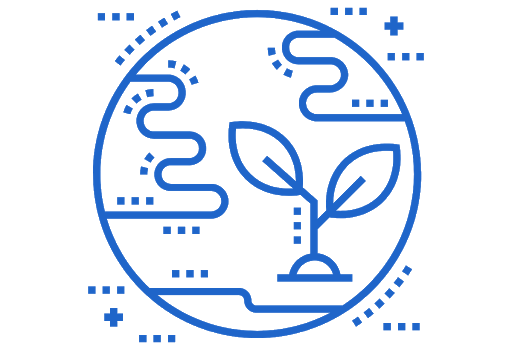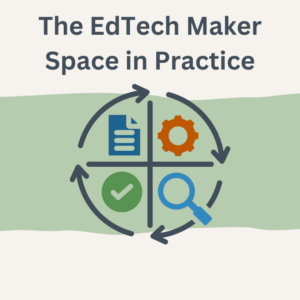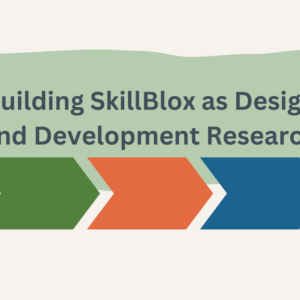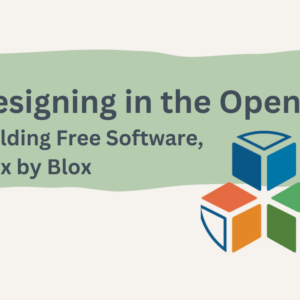By 21CLEO Research Team
During the past year, we’ve come to realize that the term learning ecosystem is widely used, but not usually defined or widely understood. Rather than taking the term for granted, we crafted this blog post to
- explore the origins of the term,
- discuss what it has come to mean, and its limitations
- explain how and why we are using the term in our study despite its limitations.
Learning Ecosystem: Origins of the term. The word ecosystem comes from ecology, the study of the interactions between living things and their environment. In the natural world, living and nonliving things interact as a system within their environment—and can have a dramatic impact when one element is affected.A well known example is the reintroduction of wolves into Yellowstone National Park in the United States. The presence of wolves in the park caused deer to avoid parts of the park where they were vulnerable to predation, ultimately changing the course of the river. Deer had previously eaten all of the vegetation in these areas, and once they started avoiding those spots, trees and bushes were able to to grow, and birds, beavers, and bears returned to those areas. The regenerating forest stabilized the banks of the rivers, which then changed course less often. While this description is oversimplified and likely overstates the impact of one aspect in the natural system, the take-away message is still important: An ecosystem is the sum of its interconnected parts.
As illustrated in the video, there is no center to an ecosystem, meaning that no one element is more important than another. However, the relationships between factors are such that a change in one factor has multiple direct and indirect impacts on many of the other factors.
An ecosystem for understanding learning. The idea of the ecosystem has been taken up within the social sciences and learning as a way to understand how the many pieces of the human experience fit together. In the 1970s, Urie Bronfenbrenner used the ecological model in his response to the “nature vs nurture” debate in understanding impacts on child development.
More recently, the term learning ecosystem has been used as a way to describe how different components interact within a learning environment. For example, in the article E-Learning Ecosystem – A Holistic Approach for the Development of more Effective Learning Environment for Small-and-Medium Sized Enterprises, the authors note that individuals within a learning ecosystem can form groups and interact spontaneously, just as organisms do, within a biological ecosystem. The way in which various stakeholders perform and adapt can contribute to or hinder the success of the learning ecosystem.
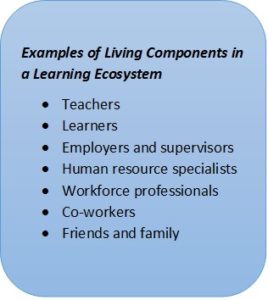 Non-living components are also part of learning ecosystems and include the physical environment and learning tools, such as media or technology. Although the definition of a learning ecosystem appears to vary depending on the focus of the stakeholders, many, if not most, use this term to focus on the role of technology in learning. This focus, however, needs to be thoughtfully considered as the authors of the article Facilitating Innovation with Technology: Key Actors in Educational Ecosystems suggest. The authors point out that in developed nations, investments into digital infrastructures has been considerable, and it is important to consider the desired or intended result before deciding whether to allocate educational funds to support e-learning rather than on other educational resources. It is also important to remember that there are nonliving components to an ecosystem that go beyond technology. In the article Freedom of Movement: Defining, Researching, and Designing the Components of a Healthy Learning Ecosystem, the author writes about the role of technology, but also discusses the use of physical space from a design perspective and argues for more accessibility within the learning ecosystem.
Non-living components are also part of learning ecosystems and include the physical environment and learning tools, such as media or technology. Although the definition of a learning ecosystem appears to vary depending on the focus of the stakeholders, many, if not most, use this term to focus on the role of technology in learning. This focus, however, needs to be thoughtfully considered as the authors of the article Facilitating Innovation with Technology: Key Actors in Educational Ecosystems suggest. The authors point out that in developed nations, investments into digital infrastructures has been considerable, and it is important to consider the desired or intended result before deciding whether to allocate educational funds to support e-learning rather than on other educational resources. It is also important to remember that there are nonliving components to an ecosystem that go beyond technology. In the article Freedom of Movement: Defining, Researching, and Designing the Components of a Healthy Learning Ecosystem, the author writes about the role of technology, but also discusses the use of physical space from a design perspective and argues for more accessibility within the learning ecosystem.
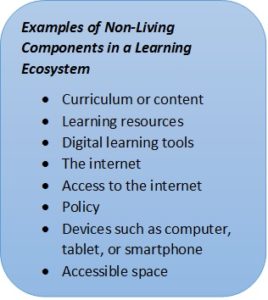 Shifts within an ecosystem. The balance of a natural ecosystem is radically impacted when one or more components become dominant, disappear, or a new organism is introduced. As can be seen in the wolf video, the absence of a predator resulted in unstable river banks and a river that frequently changed course. The reintroduction of wolves returned the river to a more stable state and included more diversity of life forms. Similar to a natural ecosystem, a learning ecosystem has no center but responds as a whole when a change is made to any of its components. However, just as a naturalist can focus a camera lens on a specific component of a natural ecosystem and shift focus as needed to get a fuller picture, each element of a learning ecosystem also can be looked at separately and focus can be shifted. With the 21 CLEO project we seek to focus our lens on the working learners so that we can elevate their voices. This will allow us to learn how both living and nonliving elements in the learning ecosystem influence the working learners’ educational paths.
Shifts within an ecosystem. The balance of a natural ecosystem is radically impacted when one or more components become dominant, disappear, or a new organism is introduced. As can be seen in the wolf video, the absence of a predator resulted in unstable river banks and a river that frequently changed course. The reintroduction of wolves returned the river to a more stable state and included more diversity of life forms. Similar to a natural ecosystem, a learning ecosystem has no center but responds as a whole when a change is made to any of its components. However, just as a naturalist can focus a camera lens on a specific component of a natural ecosystem and shift focus as needed to get a fuller picture, each element of a learning ecosystem also can be looked at separately and focus can be shifted. With the 21 CLEO project we seek to focus our lens on the working learners so that we can elevate their voices. This will allow us to learn how both living and nonliving elements in the learning ecosystem influence the working learners’ educational paths.
One of the things our initial data has shown us is that the focus on the working learner will help us explore their agency in the ecosystem. Within the existing literature, the working learners often are discussed as recipients of opportunities. Less has been said about what working learners do on their own that shape the learning ecosystem. We raise the question: How do working learners respond as changes are made to the learning ecosystem? What are the various push-pulls between the components within a learning ecosystem? For example, while employers and workforce systems have the ability to shape the learning ecosystem by introducing multiple ways of learning, incentives for learning, mandates around participating in learning, and so on, how do working learners respond by acting on their own, selecting what to respond to, turning to other avenues of support, or seeking other employment? The motivation for these questions drives the need to understand a learning ecosystem, as something not controlled by one force but instead as a series of complex negotiations among many stakeholders.

Limits of the metaphor. The learning ecosystem as a metaphor is not without its limits. Like any model of the world, the purpose of the learning ecosystem metaphor is to represent the relationships of a complex system in a straight-forward way. Designers of conceptual models make decisions about what stakeholders and elements are represented and which are de-emphasized. As a result, a complex system is stripped of its complexities and reduced to a fundamental structure. In other words, the process of making a model involves striking a compromise between simplicity and accuracy, and the true complexities are masked.
Despite the limits of using the ecosystem as a metaphor, we have chosen to continue using it because it has several strengths. First, the metaphor is one that tends to be easily understood. Even without specific terminology, most people can envision how the various plant and animal life interacts within a setting such as a wilderness river. Without too much explanation and without veering into academic language, we can discuss how each part of a learning ecosystem is impacted by other parts and in turn impacts those other parts. Additionally, the metaphor of the learning ecosystem has become well accepted within the employment sector as a way to think about how instructional design fits within the work setting. As academics thoughtfully using the language of the employment sector, we can bring a critical perspective without having to “swim upstream” by introducing unfamiliar language.
Finally, by sticking with the metaphor of the learning ecosystem, we acknowledge the work that has come before us. The articles and papers we refer to in this blog include the working learner, and often put the working learner in the center of the ecosystem. We take a slightly different approach in that we are seeing the working learner as one of the many parts of a complex ecosystem while using an analytic lens to bring the working learner into a clear focus. Our hope is that doing so will help us build a better understanding of just what their role is in the ecosystem while capturing the complexities of that system.

